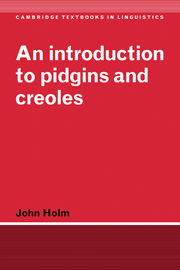
-
Select format
-
- Publisher:
- Cambridge University Press
- Publication date:
- June 2012
- August 2000
- ISBN:
- 9781139164153
- 9780521584609
- 9780521585811
- Dimensions:
- (228 x 152 mm)
- Weight & Pages:
- 0.605kg, 308 Pages
- Dimensions:
- (228 x 152 mm)
- Weight & Pages:
- 0.43kg, 308 Pages
You may already have access via personal or institutional login
Book description
This textbook is a clear and concise introduction to the study of how new languages come into being. Starting with an overview of the field's basic concepts, it surveys the new languages that developed as a result of the European expansion to the Americas, Africa, Asia and the Pacific. Long misunderstood as 'bad' versions of European languages, today such varieties as Jamaican Creole English, Haitian Creole French and New Guinea Pidgin are recognized as distinct languages in their own right. John Holm examines the structure of these pidgins and creoles, the social history of their speakers, and the theories put forward to explain how their vocabularies, sound systems and grammars evolved. His new findings on structural typology, including non-Atlantic creoles, permit a wide-ranging assessment of the nature of restructured languages worldwide. This much-needed book will be welcomed by students and researchers in linguistics, sociolinguistics, western European languages, anthropology and sociology.
Reviews
‘The style in which the book is written is generally accessible and clear … The book is generally well-produced, containing a list of abbreviations, a 15-page index, and two detailed language maps.’
Source: Journal of Pidgin and Creole Languages
Contents
Metrics
Full text views
Full text views help Loading metrics...
Loading metrics...
* Views captured on Cambridge Core between #date#. This data will be updated every 24 hours.
Usage data cannot currently be displayed.
Accessibility standard: Unknown
Why this information is here
This section outlines the accessibility features of this content - including support for screen readers, full keyboard navigation and high-contrast display options. This may not be relevant for you.
Accessibility Information
Accessibility compliance for the PDF of this book is currently unknown and may be updated in the future.


